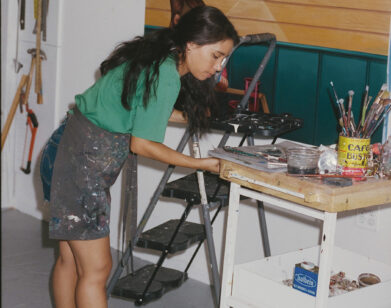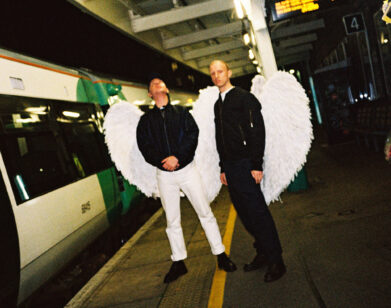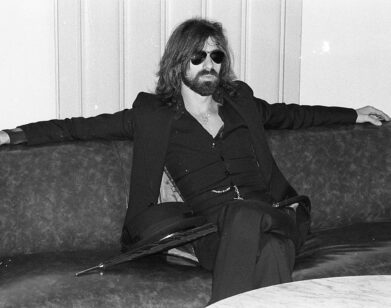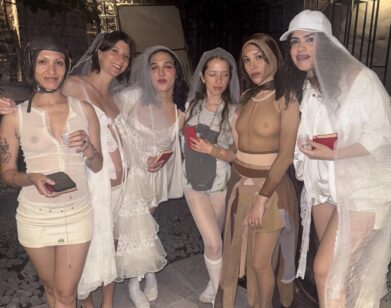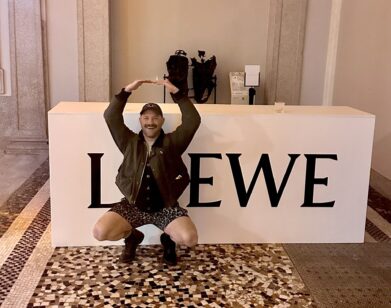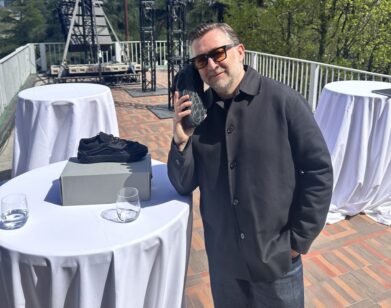Tim Murphy
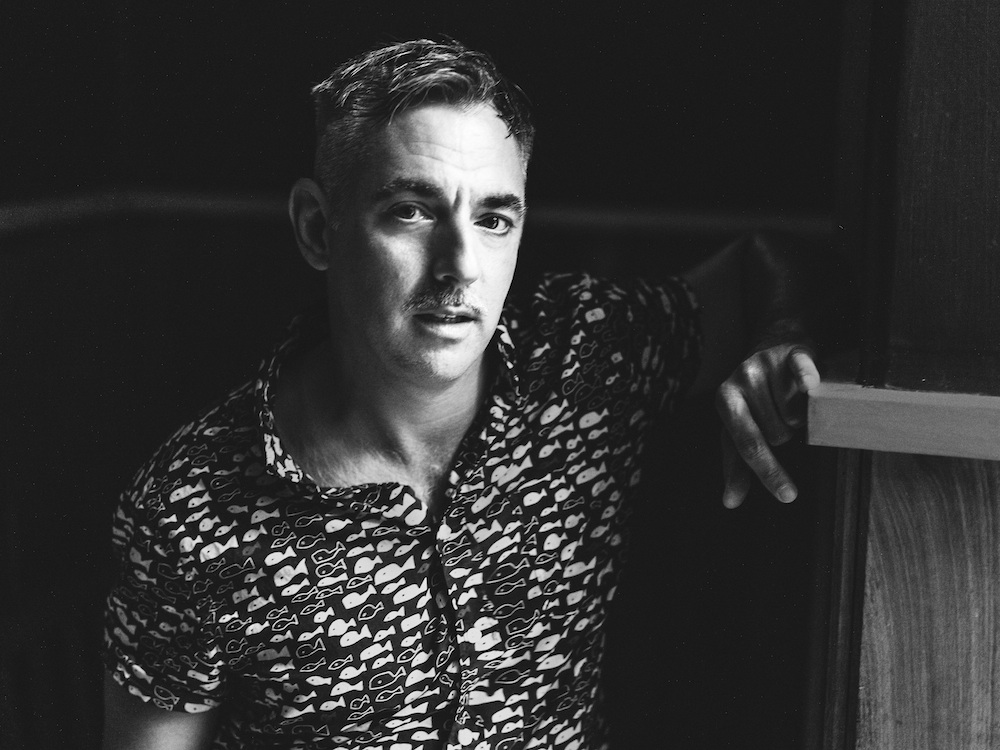
TIM MURPHY AT SISTERS IN BROOKLYN, AUGUST 2016. PHOTO: CHRISTOPHER GABELLO. GROOMING: MALIKA BELFOR/EXCLUSIVE ARTISTS MANAGEMENT USING ARTISTS BRUSHES, DR. DENNIS GROSS, AND JACK BLACK.
“They were cursed with the divine gift of having a messy life to go on living,” Tim Murphy writes of those spared the death sentence of AIDS in his brilliant new book Christodora (Grove Atlantic), this year’s most ambitious and devastating contribution to the New York City realist novel. Using Christodora, the legendary East Village apartment building more as a starting point than a frame, Murphy captures various interconnected lives struggling with the AIDS epidemic over the course of the past four decades (and into the next one). His characters range from those who contract the disease to those fighting for government assistance, basic human dignity, or even a home. Murphy is himself a journalist who has reported on HIV/AIDS for decades, so he understands the science and medical history behind the disease. Nevertheless, it’s the beauty of his storytelling that anchors this all-encompassing novel, as he records the emotional toll and frantic magical thinking in the face of so much loss. As I read Christodora, I wasn’t sure what I found more shocking: that some of his characters’ stories—including Issy, a straight Latina from a conservative Queens family, who transforms into a fearless activist—seemed so vital I couldn’t believe they hadn’t already appeared in fiction; or that Murphy, through his preternatural ability to get under the skin of his subjects, was able to pull off such a believable cast of New Yorkers. It’s the rare kind of book that not only stays with you, but haunts your entire neighborhood after you read it. And what could have easily come across as sermonizing or pedagogic, instead transforms into an ode to resilience and survival.
I sat down with Murphy in SoHo for lunch to hear about how he started writing fiction, and how he rediscovered it many lives later.
CHRISTOPHER BOLLEN: I live not far from the Christodora in the East Village—and as with any prominent building close to your house, you hear so many of its myths and histories over the years. I actually thought your book might take place entirely within its walls. But, of course, your novel is far more expansive. Did the plot grow too large for the landmark?
TIM MURPHY: When I started writing, I didn’t even see it as taking place in the Christodora. One of my best friends lives in a very similar building in the East Village. I won’t name it, but there are a few buildings in the neighborhood that have that grand, pre-war style. When I began writing the book in 2009, I just imagined it loosely set in one of these buildings.
BOLLEN: Christodora isn’t your first novel. You wrote two when you were in your late twenties.
MURPHY: Yes, Getting Off Clean and The Breeders Box. I grew up in a small town in Massachusetts, so Getting Off Clean was a very gay, interracial, class-conflict coming of age story. I moved to New York in ’91, and the second one is sort of set in the New York club world of 1989 or ’90. It was very me in my twenties. I was working at HX Magazine and was a deejay, obsessed with clubs and club music. I was also doing a lot of AIDS-related writing in my twenties for non-profits and research groups.
BOLLEN: And of course that feeds directly into the story of Christodora. Did you happen into writing about AIDS in your twenties or was that a subject you pursued?
MURPHY: I chose that. I moved to New York to be a novelist. I first worked in book publishing and started writing a lot of short fiction out of the gate. Eventually I wrote those two novels in quick succession before I turned 30.
BOLLEN: Two novels before the age of 30 is no small feat.
MURPHY: I guess, yeah. But throughout my twenties I really felt that AIDS was the defining shadow hanging over the gay community. When I moved here, I was both very scared of it and I wanted to understand it. So I volunteered for GMHC [Gay Men’s Health Crisis]. They had a magazine and they would assign me profiles. Also mind you this was 1994. So it was pre-protease inhibitor, so the death rate was still very high. There was some preventive medicine that could kind of forestall certain symptomatic sicknesses but there really was no effective treatment for HIV per se. There was a lot of sickness and death, and they would send me to interview people living with AIDS. The second one was way out in Queens to interview this really tough, biker-like, white grandma who was raising her seven-year-old Latino grandson with AIDS. His mother had died from AIDS. He was the sweetest kid, and I instantly fell in love with him.
BOLLEN: And he was HIV positive?
MURPHY: He had AIDS.
BOLLEN: He differs from one of the main characters in Christodora, in that Mateo’s mother is positive but he isn’t born with it.
MURPHY: Right. The thing is that at a certain point they realized if the mother took AZT while she is pregnant, she could prevent passing on HIV.
BOLLEN: Even simply as a history of AIDS treatment, Christodora is a massive achievement. There was so much of the science that I’d forgotten even though I watched it developing and evolving as a young man in New York.
MURPHY: Exactly. The whole treatment story of AIDS is amazing. And it’s been completely under-narrativized.
BOLLEN: There was so much confusion in the community on what these pills were doing and if this medication was working or how it was counteracting another medication. Your novel really gets to the bone of that time of hope and fear and loss. And all of the stories of—
MURPHY: —of heroism. There was such heroism at that time in the face of death and hatred. It’s amazing and it’s been so under-archived, because a lot of it happened before the nternet. So it’s under-recorded. There have been some great documentaries recently like How to Survive a Plague and United in Anger: A History of ACT UP.
BOLLEN: Those are wonderful, but what I love about Christodora is that it doesn’t just talk about the beginning. It tackles the middle and the end as well—it tells the whole story. Not just the glamour and rage of the early ACT UP protests.
MURPHY: Yes, I was interested in the aftermath. I think there was a sort of collective emotional and psychological hangover from the worst years. And I remember being sent to do these profiles and I was just struck by the relative of this sweet little boy who looked perfectly fine but I know he was probably going to die. And he did die a few years later.
BOLLEN: AIDS was devastating for the gay community, but it can be easy to forget that it afflicted people from all ages and backgrounds. I never really thought about the number of children who died.
MURPHY: It’s very rare now for babies to be born with HIV because there’s universal screening of pregnant women. So it was really a mark of another era. But there were lots and lots of stories like that. I remember there was also an older gay guy who had been blinded by CMV [cytomegalovirus], which was an infection that caused blindness. I interviewed him in his tiny studio on the Upper West Side and he had a piano. Even though he was blind, he sat and played the piano for me. It was really haunting. I was only 23 or 24. So these stories really stayed with me. Some of those people made it and some of those people didn’t—some by the dint of their personal biology or what meds they went on when. Like, people who held off on the available meds early on and went on all the new meds, fresh and clean, in general did better than the ones who went on every new thing as soon as it came out.
BOLLEN: Which is almost a punch in the stomach for those who got tested and tried to be proactive right away.
MURPHY: Yeah. Once the protease inhibitors started coming out, I began writing for a research group—that’s when I started getting wonky in terms of the medicine. After that, I went to POZ and was the main treatment writer there. And the stories that would really move me were women—women who were living with it. Because a lot of the times the gay men would be part of a gay community, so there was some understanding of it.
BOLLEN: They had people to fall back on.
MURPHY: Yes, and there was still a stigma to it. Gay men tended to have people around them who understood it. When a lot of women found out that they were positive, they were often on their own and surrounded by ignorance. Because HIV wasn’t in their life, their culture, their community. So it completely sideswiped them. Very often there was an arc. First there was despair—”I’m gonna die.” Or if it was later on, “No one will ever love me,” “No one will ever have sex with me,” “I’m living in isolation.” And then a lot of these women—especially if they got to the point where I was interviewing them for POZ—had come out or were ready to come out. They become advocates, they’d go to Capitol Hill, they’d speak at protests. It was just very moving.
BOLLEN: My favorite character in the book is Issy, and this is her arc. She becomes a leader for women’s health and the recognition of women as victims of AIDS. Issy is really a character I’ve never seen represented before in fiction. You do hear of the horrors that gay men experienced during the ’80s, but we don’t hear from the women like Issy who had no safety nets at all.
MURPHY: She goes from being a very normal, everyday person to politicized and radicalized. I also worked as a writer at Housing Works for a year and a half, and there were lots of women in the community that became activists. Issy’s story was kind of their story. And you’re right; AIDS has mostly been associated with gay men because it hit gay men, but also white gay men had the cultural means to write and publish and produce these stories. Women were a minority in terms of actual numbers. No group has been as affected numbers-wise as much as gay men even though nonwhite women have been affected much more than white women. I don’t know; I hesitate to say that there’s nothing out there written by or about women and AIDS. I just can’t think of any that has attained The Normal Heart status, you know?
BOLLEN: I can’t think of one.
MURPHY: Also, overlapping this whole period of writing for me, were a lot of troubles in my own right. I had severe, severe depression in my late twenties. Then I had a drug problem and became positive in the midst of all that. The book sort of has two layers—it’s also a very personal, visceral experience, very interior to me.
BOLLEN: How did you find a way out of that cycle of drugs and depression?
MURPHY: It took a long, long, long time after that experience of those five bad years to find out who I was and what I really wanted. Learning that took years and years after I quit. It wasn’t something that just fell into place the minute I stopped using. It took a really long time. I think functionally how I dealt with it was I just launched into journalism. That was how I rehabbed myself and reconstituted my life as an adult. I just tried to be a really good journalist.
BOLLEN: Journalism and not fiction.
MURPHY: I couldn’t write fiction. I lost it. After it being so important to me and at the center of my identity all through my twenties, I couldn’t access it again. I would try occasionally and I would just get frustrated and think it was stupid and be bored by it and just find it a wholly unsatisfying experience. I’d walk into The Strand and would just want to barf. I would just be like, “Why does anyone bother writing all these books? Hardly any of them get read anyway.”
BOLLEN: I know that feeling. I still sometimes get that in a bookstore.
MURPHY: Me too. It’s funny because part of the book coming out involves coming back into a community of writers and artists and realizing that you don’t do it because it necessarily has some immediate impact on the world. You do it ’cause you have to. And I think you also do it for the joy of being part of the community of people who make things. Coming back into an artistic, creative community in New York and into my own creative self has been very gratifying. But I couldn’t access it for many years. It’s really something I lost and found. Lost and re-found.
BOLLEN: When you finally came back to this talent or skill or practice—or whatever the hell you want to call writing—had it changed dramatically for you in terms of your approach and technique?
MURPHY: It changed a lot for me because with the books I wrote in my twenties, I outlined them. I had a very linear, just-get-it-done attitude about them. For the most part, I followed the outline. I drew the lines, and then I colored in the lines.
BOLLEN: You built an IKEA shelf of a novel. You followed the directions.
MURPHY: Kind of. When I reread them now I see how much of my inner life I was putting into them—and my worldview at that time—without knowing it. But it did feel a little bit rote.
BOLLEN: So how did you find the road back to fiction?
MURPHY: Around 2009, I was freelancing very steadily by then and had gotten my act together. And I just started feeling like, if you don’t try to write fiction again, this is going to eat at you for the rest of your life. You’re just going get more and more bitter that you did something that was so important to you, you put down, and you never picked back up. So I was like, “Ugh, okay. I’ll try.” But I had no idea what the book was that I wanted to write. So I just said, “Write a story. Just reach in and write a story about what is really sitting in your heart.” And it was these experiences of mental illness, of addiction and of AIDS. And of living my whole adult gay life in the city with that shadow. The whole arc—it was over, but it wasn’t really over. There were so many people that had survived, but there were so many people that were isolated, that were depressed. They were drug addicted. There had been suicides. It felt like a collective urban trauma that no one had really talked about. We’d all just moved on. We had all moved on into the digital age, into the Manhunt age, into the Facebook age, et cetera, and had never really parsed or reckoned with that experience.
BOLLEN: I wonder if 9/11 overwhelmed the tragedies that came right before, and we never had the chance to reckon with or process those traumas. 9/11 became the place to put all communal traumas.
MURPHY: That’s possible. The other thing, too, is that the new medication, it didn’t 100% resolve it, but they quelled it to a great extent so suddenly there wasn’t high crisis. It was an easy thing for many—not all, but many—people to live with quietly from day to day. It was no longer a priority number one, so the whole unaddressed period of time was just lying below the radar.
BOLLEN: Did the first short story you wrote become the start of Christodora?
MURPHY: It’s very similar to the first chapter. I pictured it taking place in a building like my friend’s. But most of the original characters were there. There was the nuclear family: there was Milly and Jared, and the little boy that they had adopted, and the fact that he was an AIDS orphan. And then there was Hector in their building—
BOLLEN: Another great character of yours. This sound strange but I admired that you drew such a bleak picture of his life. I think there is often a tendency for gay writers to paint these rather rosy gay characters-as if they are sort of aspiration, goodwill ambassadors of what gay men can be like for straight readers. And they don’t have to be. They can tragic, they can be dark, they can be reckless and miserable. Hector certainly is with his drug spiral. He survived the years of AIDS but his world got darker and darker.
MURPHY: Exactly, exactly. When I was using, I hooked up with so many guys that were about 10 years older than me and they had lived through the worst years and they were either positive or they weren’t, but they had still lived through the worst years. They had lived through that time and it just felt like so many of them were just using drugs and very isolated and had gone into a sort of PTSD. But I loved those guys. I really did. They felt like gay father figures to me in a way. They’d lived through so much, had so much experience and they were very hurt. And I think I was always aware of that gulf. I remember when I was 23 I dated a guy who was 33 who told me that he had been to, like, 30 funerals.
BOLLEN: I can never imagine that kind of toll so young.
MURPHY: We missed that bullet. We didn’t live through massive loss. The other thing that’s always moved me so much about that generation was that they were doing heroic work and organizing and rallying and learning all that data and that research and taking on the medical establishment…they were so young! They were in their twenties and thirties. They should have been having fun. But they were fighting for their lives. And all of that intelligence and skill and young talent and energy and they harnessed it into this amazing revolutionary change of the health establishment. I mean, never before that was there an idea that the patient would be empowered—that the patient would direct and author their own course. You were just supposed to passively accept whatever doctors told you or whatever they gave you. So, they just did something so remarkable and I think that a lot of them paid a price. When you spend most of your twenties and thirties doing that, you’re exhausted in your forties when treatment improves. I think a lot of them just crashed. With the character of Hector, I wanted to capture that. So that was the beginning. And I had the idea I’d write a collection of loosely linked short stories about various New Yorkers who are all in some state of addiction or mental illness or coming apart in some way. And I wanted there to be a slight sense of disorientation and bewilderment in the first several chapters where you’re like, “What do these people have in common?” I wanted it to start locking into place. And then, once it locked into place, to plow it home like a train. So that was really fun.
BOLLEN: I want to get back to my initial question. Why the Christodora?
MURPHY: I’ve always known of the Christodora. The Christodora’s a very plain building, and it’s really beautiful at the top, with those gargoyles and terraces at the very top.
BOLLEN: Doesn’t it have a swimming pool in the basement? I was always told that.
MURPHY: Yeah, I think there is. Over the course of writing the book, I Googled different facts about it.
BOLLEN: Did you talk to people who lived in the Christodora?
MURPHY: No. On one hand, I wanted the story to track some real life events. But I didn’t want to take it to the realm of gimmick where I incorporate every single bit of real-life information. It isn’t a history of the building, and I didn’t want that to overwhelm the story. But I will say, for one thing, I think the name is so beautiful.
BOLLEN: The Christodora sounds like a boat.
MURPHY: It means “Gift of Christ” in Greek. There is something so silent and stalwart about that building in the way that it looms over the neighborhood. It’s the only tall building on the park. I like how it’s sort of a silent witness. And to me the building symbolizes New York in many ways. It’s so impassive. Good or bad things happen to the people but the city just goes on. It just sits there indifferent to the ups and downs of the vagaries of people’s lives. New York changes so rapidly and yet New York doesn’t really change at all. It’s like an impassive God through which lives pass. The city really doesn’t care who succeeds and who fails, who lives and who dies. Someone dies and someone else moves into the building.
BOLLEN: The bless and curse of New York is that it doesn’t have respect for its own history. There is no preservation of historic sites for the sake of it. Everything will be bulldozed for the next new building. It’s not a sentimental capital like the cities in Europe.
MURPHY: St. Vincent’s Hospital, Ground Zero of the epidemic where, what, thousands of people died of AIDS, is now luxury housing for millionaires.
BOLLEN: And NYU will demolish anything that gets in the way. It’s terrible. But in a way it’s also one of the city’s strengths.
MURPHY: It’s such a metaphor for existence. Every tragedy will be forgotten. Whether it’s the Holocaust or Vietnam or AIDS. Everything disappears in the slipstream of history. That’s kind of why I wanted to use the building. It’s like a silent eye. I’ve only been in it once.
BOLLEN: What? You’ve only been inside once?
MURPHY: In the entirety of writing the book, I never set foot in it beyond the lobby. And then, last summer, right after I sold the book, some friends said, “Oh, we’re going to a friend’s birthday party there! Do you want to come?” I said, “Yeah.” I felt slightly creepy going. I was going to the birthday party of someone I didn’t even know mainly because I wanted to get inside and see the building. She lived on the second to top floor and had a balcony and a terrace on both sides. All you can see of Thompson Square Park is the treetops. All that life, all that crazy, scrappy, ratty-tatty life in that park and you can’t see any of it. It’s just a beautiful velvety green blanket.
CHRISTODORA (GROVE ATLANTIC) IS OUT NOW.

